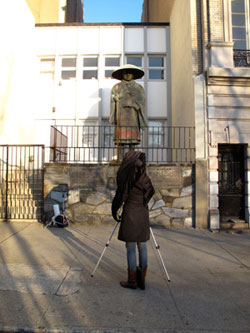The September 12 issue of The New Yorker features T.K. Nakagaki, a Japanese monk and former abbot of the New York Buddhist Church, and his work organizing a floating 9/11 lantern ceremony on the Hudson River. The article takes a look at interfaith dialogue in light of 9/11-commemoration gatherings. After Rudy Giuliani failed to invite a single Buddhist to a prayer event at Yankee Stadium that included all other major faiths of NYC, Nakagaki convinced the city’s Buddhist Council to make some noise about the omission. From “All Together Now“:
They sent the Mayor a letter of grievance and began organizing ceremonies of their own—interfaith undertakings that included, but did not rely on the hospitality of, their Abrahamic counterparts. If the Buddhist point of view was to be heard, the Buddhists, against their nature, were going to have to assert it more loudly. This was New York.

The article also references the “war-scortched relic” statue of Shinran in front of the New York Buddhist Church, featured on the cover of the Summer 2011 issue of Tricycle.
Over at The Huffington Post, Dr. Paul F. Knitter, a Christian scholar, writes about a trip he made earlier this year to the South Korean peninsula, as part of a project promoting dialogue between Christians and Buddhists. In the midst of Buddhist-Christian tension in Korea, he gave a talk to the Chogye Order of Korean Seon (Zen) Buddhists. (The head of the Chogye Order, Master Jinje, spoke in New York last night.) From “A Buddhist Example of Interfaith Dialogue“:
I realized over the course of these few but intense days, the Korean Buddhists of the Chogye Order had invited me not only to learn more about Christianity, but also to ask that I help make their teachings better known in the United States. Having witnessed the seriousness of their practice, having been moved by the openness and compassion with which they reacted to the outbursts of hatred shown by some of their Christian citizens—I am extremely happy to do so.
While we’re on the subject, champion of Buddhist-Christian dialogue Thich Nhat Hanh posted a talk this week called “Energies of Buddhism.” Thay says that mindfulness, concentration, and insight are the energies of Buddhism, much like the Holy Spirit is the energy of God.
Clearly, all the world’s religions are talking about the same thing—like the mystics have been saying all along. When you get a direct look at the transcendent reality behind appearances you realize that you have no real self. You have a unified, True Self. Right? Ummmm, probably not. In a very thorough post on his blog, David Chapman refutes the “unification” theory put forth by mystics. I would quote it here, but it’s probably best if you read the entire post.
Thank you for subscribing to Tricycle! As a nonprofit, we depend on readers like you to keep Buddhist teachings and practices widely available.